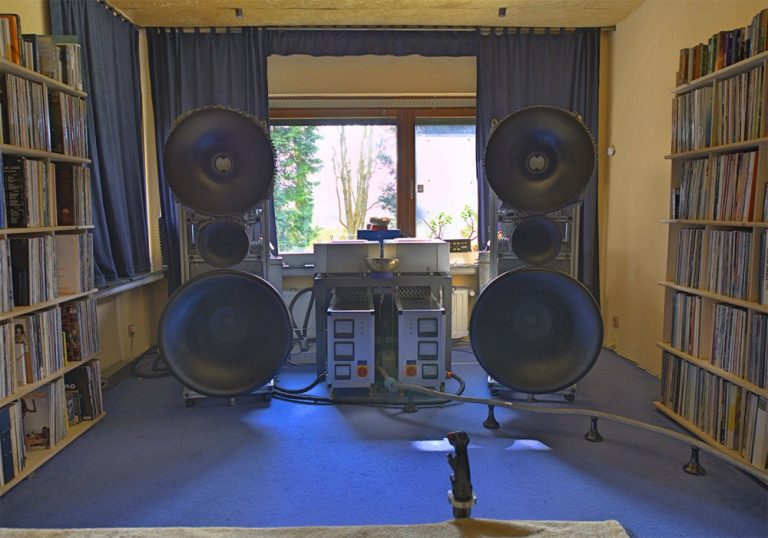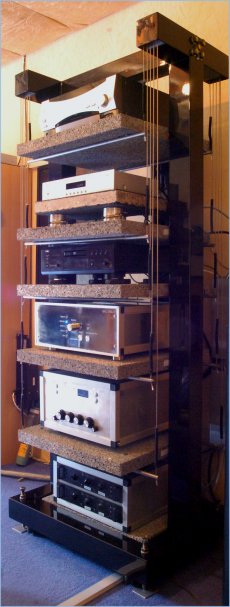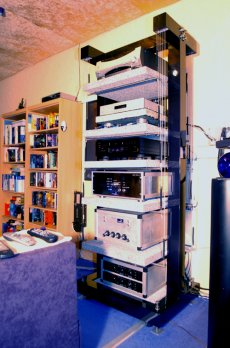KlangErlebnisWelten

Abgebildet ist unsere eigene Referenzanlange. Bei den Hornlautsprechern handelt es sich um einen reinen Prototypen, der nur auf akustische Leistungsfähigkeit entwickelt wurde, ohne den Anspruch zu stellen „wohnzimmertauglich zu sein“. In der Mitte sieht man die von uns entwickelten Single-Ended-Triode Endstufen, sowie zwei Mosfet-Solid-State Endstufen, die über eine aktive Frequenzweiche die Basshörner ansteuert.
High-End-Audio
Der Firmengründer Stephan Götze beschäftigt sich aus privatem Interesse schon seit den 70er-Jahren mit High-End-Audio. In den 80er-Jahren war er als Entwickler u.a. für die Firma Vernissage tätig.
Derzeit findet bei Gecom Technologies die Entwicklung von Prototypen statt. Da aus dem Hautgeschäftsbereich sehr viel Erfahrung im Bereich der Messtechnik und Militärtechnik besteht, werden zum Teil völlig neue Ansätze gefunden.
Ebenso werden aber auch Erkenntnisse aus dem High-End-Audio-Bereich in die Messtechnik eingebracht. So ist es z.B. im High-End-Audio-Bereich üblich, mit ausgesucht hochwertigen Netzkabeln zu arbeiten. Dies haben wir z.B. in die Messtechnik übernommen.
Zurzeit wird ein neues Verstärkerkonzept erstellt, welches nach Patentierung Herstellern zur Lizenz angeboten wird.
Der Schwerpunkt unserer Arbeit liegt inzwischen in der Entwicklung hochwertiger High End Audio Elektronik und Komponenten für Hersteller. Hierbei wird der gesamte Ablauf von uns begleitet: Beginnend mit der Konzepterstellung über Bau, Optimierung und Prüfung von Prototypen bis hin zur Produktionsbegleitung.
Selbstverständlich können auch Platinenlayouts, bestückte Platinen und Sonderbauteile gestellt werden.
Brief overview of our projects
Unfortunately the site is not completely available in English at the moment but to help our foreign customers we have a brief overview of our system here.
Background to the system: In 2004/2005 I heard some very good systems such as Kharma & Avalon using the new Thiel ceramic chassis. I liked the reproduction very much, but I felt it lacked dynamics. So the idea came up to build a horn-system around them. The bass should give no problem as I could use the Oris-horns with Wolf von Langa field coil chassis. I wanted the ability to adjust phase for optimal conditions at my listening position, so I build a structure made by Rexroth alloy profiles. So the single drivers can be adjusted to high accuracy, using measurement equipment, and of course listening tests.
All empty voids are filled with sand, to avoid resonance. The cabinets for bass and midrange have rectangular form housings but the internal structure is more or less „drop-shaped“ and formed in a matrix. The outside of the bass cabinet is covered with alloy foam, to avoid reflections and resonances. The midrange horn is made of ceramic while the tweeter-horn is made of a reinforced resin. All surfaces are covered with acoustic foam to attenuate reflections. The speakers are a rather heavy at around 380 kg each! The new Feastrex drivers could also be very tempting to test in this system.
The sofa is basically a big subwoofer with a volume of 200 liters. Inside there is a 38 cm Focal woofer. This subwoofer is controlled by a Volodyne SMS-1. This is design not to extend the bass as the Oris System goes already goes low but rather to correct for any acoustic modes in the listening room. It may look like a sofa but the base plate is concrete and also a lot of sand is used for damping. Again it is rather substantial weighing in at 470 kg!
The power amps are a new SET construction, with many novel ideas being deployed:
The first step is a quality power supply, all necessary voltages have there own separate transformers and except the plate voltage for the GM-70 output tube and all voltages are regulated. I used substantial capacitors are used in the power supplies: there are 15000µF/ 450 V for anode voltage of the drivers, 150000µF/35V for the driver heaters, 80000µF/63 V for the GM-70 heater, 5000µF /350V for the bias and 33000µF/500V for the plate voltage of the output tube. Of course inductors and film capacitors are also fully deployed to ensure to absolute purist power supply is available to each module. The power supply start up is controlled by a sequencer to avoid tube wear and to run at controlled conditions all the time. A lot of security & safety mechanisms are also built in. All the power supplies are mounted on low resonance boards while the complete audio circuit is mounted on a spring loaded sub chassis tuned to 2 Hz .
The tubes are hidden to the listener to prevent any acoustic or rf interference and are cooled by ultra low noise fans, which are inaudible at 1m ( 17 dBa). The housing is made of a special alloy utilizing a special sandwich construction giving excellent rf-shielding and offering excellent acoustic properties including no resonance-frequency. The output transformers are custom made toroidal transformers weighting in at around 20 kg. The results as well for measurements and acoustics are very outstanding. With an untypical „tube sound“ this unique design offers all the tube benefits coupled with extremely fast, clear and dynamic reproduction.
The bass amps are solid state designs with enough power and also offering very fast performance. I would rate them as a good standard design with performance power supplies with substantial reserves.
Source is a heavily modified CEC-TL-51 CD-player. Especially noteworthy is the master-clock which derives its reference frequency from in house caesium standards.
D/A converter is based on a hoerwege DAC-UP 1794 with an own ultra stable & ultra low noise battery power supply.
For video there is a Denon DVD-1 and a Kenwood AV-receiver (but this will be replaced in the near future).
The main preamp is a custom construction which also incorporates several new ideas. I attend to apply to patent many aspects of this so I can make no further comment on this!
The rack is another custom construction with very good decoupling abilities which is especially important for the CD player where I use a pneumatic suspended platform of alloy foam.
Cables for the midrange/tweeter section are AudiaZ and for the bass a 4 x 4mm² shielded configuration is deployed. Other interconnects are usually custom made of pure silver and the long interconnect between preamp and the SET amps is an active shield design.
I spent a lot of effort on the line power and grounding: Preamps and sources are run from an AC power source, powered by batteries (280 AH at 24 V) and then I´ve matched line filters to every single component. The power amps use isolation transformers and matched filters. This offers the highest order of suppression of any mains borne interference and disturbance.. All the casings of the units are connected to the „normal“ earth, but the audio ground is galvanically separated and runs on a separate earth (an anchor in the garden).
The room is acoustically treated: Rear wall has a 10 cm thick cover of acoustic foam while ceiling 2 cm of acoustic foam. The bookshelves are damped and treated to give remove all resonance. The books/records themselves are optimally arranged for drive maximum diffraction of sound. The room is quite neutral and nothing can rattle!
Building most of the gear myself was real fun and also much more economical than simply buying gear. The results of a tailored system like that are simply better than that of most systems bought from commercial made components.
On the right side You see a picture of our line filter/ line processing unit.








